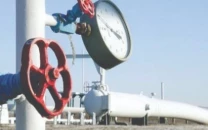China, Japan growth to slow sharply in 2016, IMF warns
Government stimulus measures, lower commodity prices and low unemployment will help drive regional expansion

PHOTO: REUTERS
Government stimulus measures, lower commodity prices and low unemployment will help drive regional expansion, the International Monetary Fund said, and called on leaders to push on with reforms.
However, in its Regional Economic Outlook for Asia and the Pacific, the Fund also warned of several external challenges, from weakness in advanced economies, weak global trade and increasingly volatile global financial markets.
Pakistan no longer needs IMF: Dar
Since its previous outlook on the region in October, global markets have seen wild volatility, with worries over China's economy and plunging oil prices hammering shares in January and February, wiping trillions off valuations. While there has been a slight recovery since March, investors remain on edge.
"Asia remains the most dynamic part of the global economy but is facing severe headwinds from a still weak global recovery, slowing global trade, and the short-term impact of China's growth transition," the Fund said.
"To strengthen its resilience to global risks and remain a source of dynamism, policymakers in the region should push ahead with structural reforms to raise productivity and create fiscal space while supporting demand as needed."
The Fund predicted growth in Asia to come in at 5.3 percent this year and next, down from its previous forecast of 5.4 percent.
China's economy, the world's second biggest and a crucial driver of global growth, is tipped to expand 6.5 percent this year -- the lower end of Beijing's target -- and 6.2 percent in 2017.
The figures are well down from the 6.9 percent seen in 2015, which was the slowest rate in a quarter of a century, but slightly better than the IMF's October outlook.
"While Asia remains the global growth engine, the external environment is becoming much more difficult," said Rhee Chang-Yong, director of IMF's Asia and Pacific Department, speaking to reporters Tuesday.
The Fund noted China's leadership is trying to transform the country's growth driver away from a reliance on government investment and exports to one dominated by domestic consumption.
IMF says Pakistan ready to go it alone when programme ends
It also warned of the spillover effects of China's slowing growth on other economies that rely on the country to drive their own expansion, including weaker trade and commodity prices.
"Overall, the region has become more sensitive to the Chinese economy," it said.
Countries with strong China trade relations had suffered the greatest repercussions from its stocks rollercoaster, Rhee told reporters.
"When the China stock market moved quite significantly (last year)...the financial spillover was higher in countries with strong trade links with China," he said.
Rhee also warned that policy makers would have to balance the expansion of credit with the strain it could cause to corporates and banks.
"We have to build strength during turbulent times," he said.
Japanese growth is tipped to slow, with the Fund saying exporters would be hit by the strengthening yen -- which is at 18 month highs against the dollar -- and slowing trade with China.
It halved its growth outlook for Japan to 0.5 percent in 2016 and tipped it to shrink 0.1 percent owing to an expected consumption tax rise, while it also cited the long-running problem of an ageing population and a huge debt mountain.
The lower outlook comes days after the Bank of Japan refused to ramp up its stimulus programme despite a string of weak data that have raised questions about Prime Minister Shinzo Abe's faltering drive to kickstart growth.
IMF 'encouraged' by PIA reform step, awaits more plans
The report said India would grow 7.5 percent this year and next, unchanged from its previous prediction and the fastest rate among the world's big economies, as low oil prices, government investment and a pick-up in domestic consumption offset weak exports.
In South Korea, growth was forecast to rise to 2.7 percent this year and to 2.9 percent in 2017 -- up from 2.6 percent in 2015 and again boosted by domestic demand. Australia's growth is expected to remain stable at 2.5 percent in 2016 and pick up in 2017.



















COMMENTS
Comments are moderated and generally will be posted if they are on-topic and not abusive.
For more information, please see our Comments FAQ